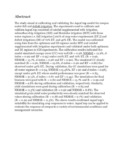Calibration and validation of the AquaCrop model for full and deficit irrigated cowpea (Vigna unguiculata (L.) Walp)

Date
2021-11Author
Kanda, Edwin Kimutai
Senzanje, Aidan
Mabhaudhi, Tafadzwanashe
Metadata
Show full item recordAbstract
The study aimed at calibrating and validating the AquaCrop model for cowpea under full and deficit irrigation. The experiments used to calibrate and validate AquaCrop consisted of rainfed supplemented with irrigation, subsurface drip irrigation (SDI) and Moistube irrigation (MTI) with three water regimes i.e. full irrigation [100% of crop water requirement (ETc)] and deficit irrigations (DI) of 70% ETc and 40% ETc. The model was calibrated using data from the optimum and DI regimes under MTI and rainfed supplemented with irrigation experiments and validated under both optimum and DI regimes in SDI experiments. The calibration results indicated the model simulated canopy cover (CC) very well (R2 = 0.98, NRMSE = 12.2%, d-index = 0.99 and EF = 0.95) under 100% ETc and 70% ETc (R2 = 0.96, NRMSE = 15.7%, d-index = 0.98 and EF = 0.90). The simulated CC closely matched (R2 = 0.96, NRMSE = 19.6%, d-index = 0.96 and EF = 0.86) the observed under 40% ETc. During validation, the CC simulations were good for all water regimes R2 ≥ 0.94, NRMSE ≤15.4%%, EF ≥ 90 and d-index = 0.98), except under 40% ETc where model performance was poor (R2 = 0.85, NRMSE = 37.5%, d-index = 0.87 and EF = 0.45). The simulations for final biomass were good with R2 = 0.80 and NRMSE = 15.7% and R2 = 0.99 and NRMSE = 9.8% during calibration and validation, respectively. Similarly, yield simulations were good during calibration (R2 = 0.85 and NRMSE = 11.3%) and validation (R2 = 0.96 and NRMSE = 8.8%). The simulated grain yield water productivity wwa closely matched the observed values during calibration (R2 = 0.88 and NRMSE = 9.7%) and validation (R2 = 0.99 and NRMSE = 11.5%). The above results confirmed AquaCrop's suitability for simulating crop responses to water. AquaCrop can be applied to evaluate the response of cowpea to a variety of environmental conditions and management scenarios.
URI
https://doi.org/10.1016/j.pce.2020.102941https://www.sciencedirect.com/science/article/pii/S1474706520303867?via%3Dihub
http://ir-library.mmust.ac.ke:8080/xmlui/handle/123456789/1791
Collections
- Gold Collection [989]
